The influence of sports marketing communication on brand equity
Main Article Content
Abstract
The objective of this research is to study the influence of sports marketing communications on brand equity. The population of the study were the participants in sports activities in the central region of Thailand. The data were collected by using 400 questionnaires. Data analysis was done by regression analysis. The factors of sports marketing communication affect perceived brand equity. 4 of 6 sports marketing communication factors are statistically significant at the level of 0.05, namely, exclusive event marketing factor, advertising factor, public relations factor and direct marketing factor.
Article Details
The article must be considered and accepted for publication by the editorial board of the Faculty of Management Science, Lampang Rajabhat University. The articles have been reviewed by a peer (peer review) and the author must update according to the suggestion if available before publication. Articles that are not considered the editorial team will inform the results of the consideration but will not send the original to the author.
JMMS is the Faculty of Management Science journal, Lampang Rajabhat University. Jmms published both print and online editions. We allow the use of articles for academic use under the scope of copyright law.
References
อุมารินทร์ ราตรี. (2563). แนวทางการพัฒนากลยุทธ์การตลาดในการสร้างมูลค่าเพิ่ม สำหรับตลาดการท่องเที่ยวเชิง
กีฬา : กรณีศึกษากิจกรรมการวิ่งเพื่อสุขภาพในจังหวัดอุบลราชธานี. วารสารมหาวิทยาลัยราชภัฏธนบุรี,
(1),139-161.
Aaker, D. (2009). Aaker’s Brand Equity Model. EURIB: European Institute for Brand Management.
Broyles, S. A., Schumann, D. W., & Leingpibul, T. (2009). Examining Brand Equity Antecedent /
Consequence Relationships. Journal of Marketing Theory and Practice, 17(2), 145-162.
Cochran, W.G. (1977). Sampling Techniques. (3rd.). In Bartlett, J.E., Kotrlik, J.W., and Higgins, C.C.
Cochran, W.G. (2001). Organizational Research: Determining Appropriate sample Size in Survey
Research. Information Technology, Learning, and Performance Journal, 19(1), pp 43-50.
Duncan, T. (2008). Principles of Advertising & IMC, (2nd ed). New York: McGrawHill/Irwin.
Grohs, R., & Reisinger, H. (2014). Sponsorship Effects on Brand Image: The Role of Exposure and
Activity Involvement. Journal of Business Research, 67(5), 1018-1025.
Kim, J., Kang, J. H., & Kim, Y. K. (2014). Impact of Mega Sport Events on Destination Image and Country Image. Sport Marketing Quarterly, 23(3).
Kotler, P. (2003), Marketing management. Upper Saddle River, NJ: Prentice-Hall.
Madhavaram, S., Badrinarayanan, V., & McDonald, R. E. (2005). Integrated Marketing Communication (IMC) and Brand Identity as Critical Components of Brand Equity Strategy: A Conceptual Framework and Research Propositions. Journal of Advertising, 34(4), 69-80.
Schultz, D. E. (1992). Integrated marketing communications. Journal of Promotion Management, 1(1), 99-104.
Shilbury, D., Quick, S., Funk, D., Westerbeek, H., & Karg, A. (2020). Strategic Sport Marketing. Routledge.
Shimp, T. A. (2000). Advertising, Promotion & Supplemental Aspects of Integrated Marketing Communications. Dryden Press.


